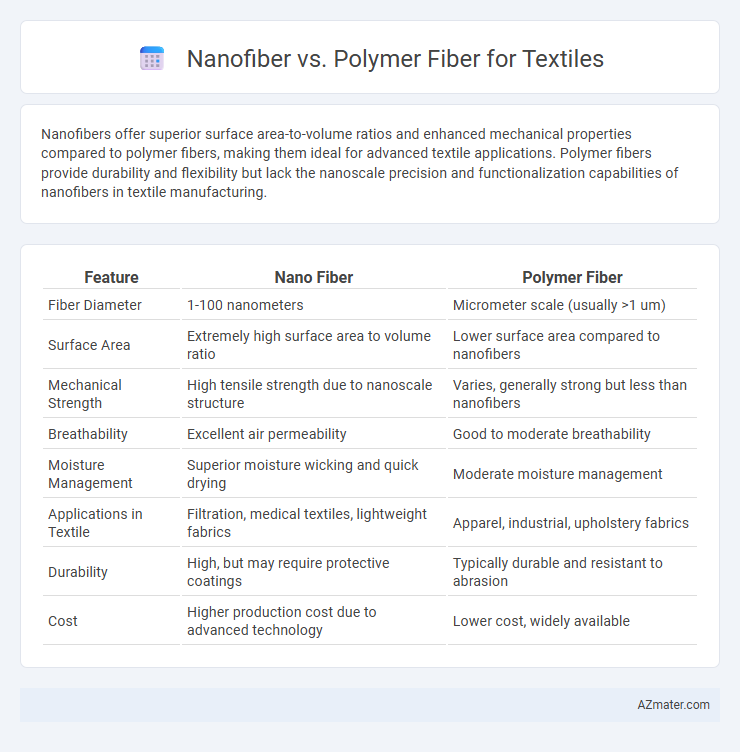Nanofibers offer superior surface area-to-volume ratios and enhanced mechanical properties compared to polymer fibers, making them ideal for advanced textile applications. Polymer fibers provide durability and flexibility but lack the nanoscale precision and functionalization capabilities of nanofibers in textile manufacturing.
Table of Comparison
| Feature | Nano Fiber | Polymer Fiber |
|---|---|---|
| Fiber Diameter | 1-100 nanometers | Micrometer scale (usually >1 um) |
| Surface Area | Extremely high surface area to volume ratio | Lower surface area compared to nanofibers |
| Mechanical Strength | High tensile strength due to nanoscale structure | Varies, generally strong but less than nanofibers |
| Breathability | Excellent air permeability | Good to moderate breathability |
| Moisture Management | Superior moisture wicking and quick drying | Moderate moisture management |
| Applications in Textile | Filtration, medical textiles, lightweight fabrics | Apparel, industrial, upholstery fabrics |
| Durability | High, but may require protective coatings | Typically durable and resistant to abrasion |
| Cost | Higher production cost due to advanced technology | Lower cost, widely available |
Introduction to Nano Fibers and Polymer Fibers
Nano fibers, characterized by diameters less than 100 nanometers, provide exceptional surface area, mechanical strength, and filtration efficiency, making them ideal for advanced textile applications. Polymer fibers, typically composed of macromolecules like nylon, polyester, or polypropylene, offer versatility, durability, and ease of processing for mainstream textile manufacturing. Understanding the fundamental differences in scale and material properties between nano fibers and polymer fibers is crucial for optimizing performance in applications such as protective clothing, filtration membranes, and high-strength composites.
Structural Differences Between Nano Fibers and Polymer Fibers
Nano fibers exhibit a significantly smaller diameter, typically less than 100 nanometers, compared to conventional polymer fibers, which range from micrometers to millimeters. The high surface area-to-volume ratio of nano fibers enhances properties like porosity and mechanical strength, while polymer fibers possess a more homogeneous structure with larger molecular chains. Structurally, nano fibers form intricate networks of interconnected fibrils, whereas polymer fibers have a more continuous and orderly molecular arrangement, influencing their respective applications in textile engineering.
Manufacturing Processes: Nano Fiber vs Polymer Fiber
Nano fiber manufacturing primarily involves electrospinning, which generates ultra-fine fibers with diameters in the nanometer range, enhancing textile properties such as strength and breathability. Polymer fiber production typically uses melt spinning or solution spinning methods to create fibers with larger diameters, offering durability and flexibility for textile applications. The precise control in electrospinning allows for the fabrication of nanofiber mats with high surface area and porosity, contrasting with the mass production efficiency and structural uniformity of polymer fibers.
Mechanical Properties and Performance
Nano fibers exhibit superior mechanical properties compared to traditional polymer fibers, offering higher tensile strength, elasticity, and durability due to their nanoscale diameter and increased surface area. Polymer fibers typically have larger diameters and lower strength-to-weight ratios, which can limit their performance in high-stress textile applications. The enhanced mechanical performance of nano fibers makes them ideal for advanced functional textiles requiring improved strength, flexibility, and wear resistance.
Breathability and Comfort in Textiles
Nanofibers in textiles offer superior breathability due to their high surface-area-to-volume ratio and nanoscale porosity, which facilitates efficient moisture vapor transmission and air permeability. Polymer fibers, while durable, often have larger diameters and less effective pore structures, leading to reduced airflow and moisture management compared to nanofibers. The enhanced breathability of nanofiber-based textiles significantly improves wearer comfort by maintaining optimal temperature and humidity levels during extended use.
Applications in Modern Textile Industry
Nanofibers exhibit exceptional surface area-to-volume ratios and enhanced mechanical strength, making them ideal for high-performance textiles used in filtration, medical fabrics, and protective clothing. Polymer fibers, such as polyester and nylon, provide durability and elasticity, widely applied in everyday apparel, sportswear, and industrial textiles. The integration of nanofibers into polymer matrices advances functionalities like moisture management, antimicrobial properties, and lightweight thermal insulation in modern textile manufacturing.
Durability and Longevity Comparison
Nano fibers exhibit superior durability and longevity in textile applications due to their high surface area-to-volume ratio, which enhances mechanical strength and resistance to wear. Polymer fibers, while widely used and cost-effective, tend to have lower tensile strength and are more susceptible to degradation from UV exposure and abrasion over time. The enhanced durability of nano fiber textiles makes them ideal for high-performance and long-lasting fabric solutions.
Environmental Impact and Sustainability
Nanofibers in textiles offer superior filtration and lightweight properties while requiring less raw material, resulting in lower environmental footprints compared to conventional polymer fibers such as polyester or nylon. Polymer fibers, primarily derived from petrochemicals, contribute significantly to microplastic pollution and greenhouse gas emissions during production and degradation. Enhanced sustainability in nanofiber technology is attainable through the use of biodegradable polymers like polylactic acid (PLA) and green electrospinning methods, reducing toxic solvent use and improving end-of-life recyclability.
Cost Efficiency and Scalability
Nano fibers in textiles offer superior strength-to-weight ratios and enhanced material properties but come with higher production costs due to advanced manufacturing techniques like electrospinning. Polymer fibers, made from established processes such as melt spinning, provide cost-effective scalability suitable for mass production in the textile industry. Choosing polymer fibers improves overall cost efficiency, while nano fibers are optimal for specialized applications where performance justifies higher expenses.
Future Trends in Fiber Technology for Textiles
Nano fibers exhibit superior mechanical strength, increased surface area, and enhanced breathability compared to conventional polymer fibers, driving innovation in smart textile applications. Future trends in fiber technology emphasize integrating nano fibers with functional coatings to enable self-cleaning, antimicrobial properties, and improved moisture management in wearable fabrics. Advancements in scalable nano fiber production and sustainable polymer composites are expected to revolutionize the textile industry by combining performance with environmental responsibility.

Infographic: Nano fiber vs Polymer fiber for Textile
 azmater.com
azmater.com